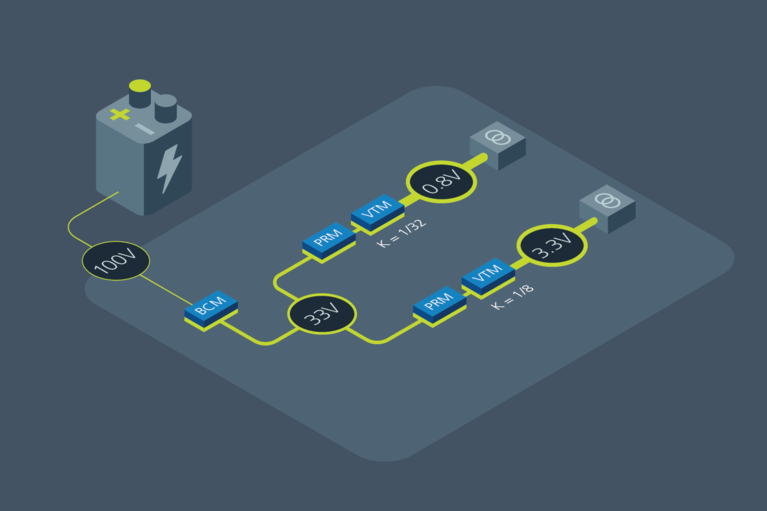
使用 MOSA、SOSA 和 VPX 開放式架構的未來標準化防禦平臺
使用 MOSA、SOSA 和 VPX 開放式架構的未來標準化防禦平臺
尊敬的用戶:
為了改進 Vicor 網站,我們將於美國東部時間 12 月 29 日上午 11:30 至下午 2:00 對網站進行維護。
在此期間,您可能無法查看網站的某些部分,特別是產品頁面和產品型號清單。
對於給您帶來的不便,我們深表歉意,並感謝您的耐心等待。
– Vicor 網站團隊
太空是一個充滿挑戰且不容許任何差錯的環境,要求設備具備最高效能和絕對可靠性。因此,仔細選擇最適合應用的產品至關重要。對於低地球軌道(LEO)和中地球軌道(MEO)衛星而言,耐輻射部件是確保卓越性能和延長任務壽命的最佳選擇。Vicor 公司成熟的耐輻射高密度電源模組性能卓越,並經過嚴格測試,能够承受太空環境的嚴苛考驗。
作者:Ken Coffman,高級現場應用工程師;Salah Ben Doua,首席應用工程師
太空中的電子系統面臨諸多危險,包括持續受到電磁波和粒子輻射的影響。半導體器件特別容易受到粒子輻射的影響,這可能導致混亂和系統故障。
然而,並非所有太空應用都需要相同程度的輻射防護。 例如,深空探測任務使用昂貴的耐輻射强化組件,而當今的新太空應用,如運行在 LEO(低地球軌道)和 MEO(中地球軌道)的衛星,則只需要“耐輻射”的組件和電路。
如圖 1 所示,電磁波輻射和粒子輻射雖然相關,但對系統的影響卻有所不同。 單個粒子的質量雖小,但可以加速到極高的速度。 它們還可能攜帶電荷——通常由於原子軌道中的負電荷電子被剝離而帶正電荷。

圖 1:輻射譜。
粒子輻射可能造成物理損壞,尤其是對電晶體晶格結構的破壞,這種損傷可能是永久性的和/或累積性的。當電子被拖入耗盡區並使非導電區導電時,系統也會出現暫時性故障。
另一方面,如果正離子取代晶體矩陣中的摻雜原子,就可能造成永久性損傷,使不應導電的電晶體開始導電,從而因電路故障而造成永久性損壞。
很大一部分輻射損傷是累積性的,所以任務的持續時間將始終是一個無法回避的因素。
在當今迅速發展的新太空商業環境中,發射和更換失效衛星的成本十分高昂,因此精心設計至關重要。
選擇耐輻射的組件。某些電晶體工藝節點改進了耐輻射性能。雙極型電晶體可以根據位移損傷等級進行選擇,而寬帶隙(GaN)場效應電晶體(FET)具有固有的耐輻射能力。某些環氧樹脂和鋁電解電容在真空中會釋放氣體,囙此不適合在太空環境中使用。
考慮到不同批次之間的差异,應對多批次產品的耐輻射效能進行抽樣測試。
可以採用多重冗餘設計。物理冗餘是一種保障措施。如果一個系統失效,另一個可以接替工作。 在某些系統中,有三個並行運行的系統,如果其中一個與另外兩個不一致,其輸出就可以被忽略。
可以降低功率金屬氧化物半導體場效應電晶體(MOSFET)的額定值,這樣即使在不可避免的栅源電壓(VGS)閾值降級後,器件在任務結束時仍能正常工作。
遮罩可以保護敏感的電子設備,但如果粒子能量足够高,級聯的遮罩粒子反而可能加劇問題。
可以添加電路來監控效能,如果故障可恢復,則可以斷開並重啓不一致的系統。
然而,無論採用什麼設計策略和電源拓撲結構,新太空電子系統都必須經過嚴格的分析、模擬和測試,以確保其環境和耐輻射性能。
軟開關拓撲結構(相比於硬開關電源轉換器)能够降低寄生效應對系統的影響,如新增開關組件的電壓應力引起的振鈴現象。
評估拓撲結構時需要考慮的因素包括功率密度、效率、瞬態回應、輸出紋波、電磁干擾(EMI)輻射以及成本。
MOSFET 的開關損耗主要來自柵極電荷需求和漏源電容。
隨著開關頻率的提高,開關損耗也會新增,這就限制了開關頻率的進一步提升。體二極體的導通損耗進一步降低了硬開關轉換器的電源轉換效率。
雖然 GaN FET 沒有物理的體二極體,但它們確實有一個電壓為幾伏特的反向導通模式,這使得 GaN 器件的死區導通期變得非常難以管理。
在同步硬開關降壓拓撲中,高邊 FET 在其兩端電壓最大時開啟,並在工作週期的開通階段導通最大電流(如圖 2 左側所示)。輸入電壓越高,功率損耗就越大,因此在高電壓比應用中(如 28V 降至 3.3V),轉換器的效率會比轉換比更高的轉換器(如 5V 降至 2.5V)要差。
圖 2:拓撲寄生效應。傳統硬開關降壓轉換器(左)與零電壓開關(ZVS)降壓轉換器(右)對比。
軟開關技術可以减少開關損耗。零電壓開關(ZVS)科技是軟開關的一種典型應用,它提高了各種電源拓撲的轉換效率。ZVS 在開關電壓接近零或為零時開啟高邊 FET(參見圖 2 右側)。
利用 ZVS 技術操作鉗比特開關,可以在高低邊開關都關閉時,在輸出電感中儲存少量能量。轉換器利用這部分原本會被浪費的能量來對高邊 FET 的輸出電容進行放電,並給同步 FET 的輸出寄生電容充電。
通過消除 FET 輸出電容在開關開啟過程中的影響,設計人員可以不用過分關注柵極-漏極電容(Cgd),而將注意力集中在導通狀態下的通道電阻上,而不是通道電阻與柵極電容的乘積等傳統的性能名額。
這種在開啟期間驅動高邊 FET 的方法可以避免激發開關的寄生電感和電容,這些寄生參數在硬開關拓撲中往往會產生諧振,引起大幅電壓尖峰和振鈴(見圖 3a)。通過消除尖峰和减少振鈴(見圖 3b),ZVS 技術不僅减少了一個功率損耗項,還消除了一個電磁干擾(EMI)源。
圖 3:硬開關與軟開關波形對比。
通過消除開關過程中的電壓尖峰,設計人員可以選用導通電阻(RDSON)更低的低電壓場效應電晶體(FET),從而提高效率。
Vicor 是眾多開發軟開關技術的公司之一,並將其運用於耐輻射電源模組解決方案,為中地球軌道(MEO)和低地球軌道(LEO)衛星應用的高性能通訊 ASIC 供電(見圖 4)。 這些系統模組在 PRM™ (電源調節模組)中使用零電壓開關(ZVS)降壓-升壓拓撲結構,而在 BCM®(母線轉換器模組)和 VTM™ (電壓轉換器模組)中則同時運用了零電壓開關(ZVS)和零電流開關(ZCS)正弦幅值轉換器™ (SAC™) 技術。
圖 4:高功率諧振(零電壓開關和零電流開關)拓撲模組。
電壓轉換模組(VTM)體積小巧,可以盡可能靠近 ASIC 放置。在滿足現代 ASIC、FPGA、CPU 和 GPU 等的大電流需求時,優化配電網路(PDN)至關重要。
因此,Vicor 公司的模組結合了軟開關方案、耐輻射的有源組件和車規級無源組件。
為了降低單事件功能中斷的影響,所有耐輻射模組都包含完全冗餘的並聯動力系統。如果一個動力系統因單一事件而受到干擾,其保護電路會強制執行斷電復位。在復位期間,冗餘動力系統承擔全部負載,復位完成後兩個動力系統再次並聯運行。
設計新的太空電源轉換器時,選擇合適的拓撲結構和開關模式也是非常重要的考慮因素,此外還有許多其他因素需要權衡。
本文最初由 New Electronics 發佈。
Ken Coffman,高級現場應用工程師,被指派到 Vicor 新太空計畫工作。他住在亞利桑那州鳳凰城。您可以給 Ken 發郵件,郵箱地址為: kcoffman@vicr.com 。
Ken Coffman,高級現場應用工程師
Salah Ben Doua, 首席應用工程師,在電源設計領域擁有 30 年的豐富經驗,為 Vicor 客戶提供支持已有 20 餘載,主要為包括航空航太與國防、工業、鐵路、照明與通訊在內的眾多領域的 DC-DC 和 AC-DC 電源系統開發提供專業技術及諮詢。Salah 畢業於圖盧茲國家理工學院(the National Polytechnic Institute of Toulouse),獲電源轉換專業博士學位。
Salah Ben Doua,首席應用工程師
使用 MOSA、SOSA 和 VPX 開放式架構的未來標準化防禦平臺
使用 MOSA、SOSA 和 VPX 開放式架構的未來標準化防禦平臺
為新太空應用提供更高的功率密度和低雜訊
為太空通訊應用提供最佳功率和低雜訊所需的專利電源設計科技和架構
Spacechips 大電流處理器為在軌 AI 驅動通訊供電
小型衛星亟需具備精密運算能力。 瞭解更多低雜訊、AI 賦能的電源如何推動創新應用
電流倍增器:為 AI 處理器及其他嚴苛應用供電的明智之選
AI 處理器需要解决低電壓、高電流的嚴苛挑戰,這將會導致電源系統設計產生瓶頸。瞭解 Vicor 的電流倍增技術如何改變這一現狀








